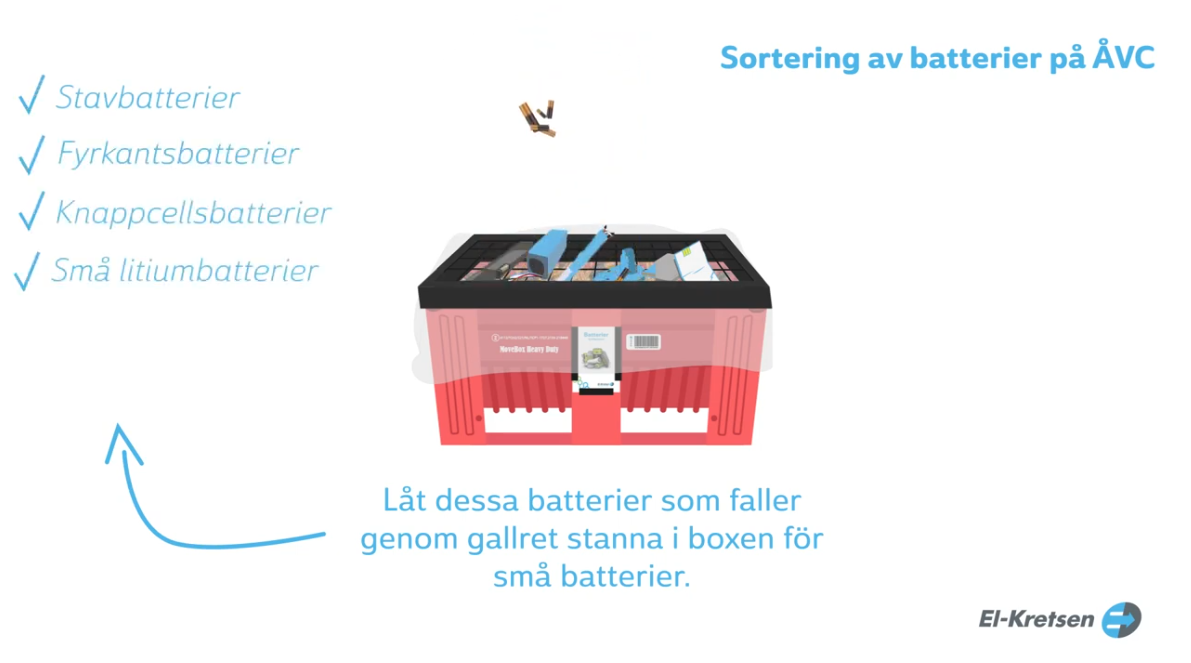För ÅVC:er
How to Handle Lithium Batteries
Waste from lithium batteries requires special handling. Here we have gathered everything you need to know if you work at a recycling centre.
The share of lithium-based batteries in the collection stream is steadily increasing. Because damaged or defective lithium batteries may have flammable properties, they must be handled in a specific way. This is in accordance with the Swedish Civil Contingencies Agency’s (Myndigheten för Samhällsskydd och Beredskaps föreskrifter, MSB) regulations on the transport of dangerous goods by road (ADR-S), which include special packaging rules for batteries and requirements for dedicated battery boxes.
All El-Kretsen’s battery boxes have undergone a range of tests and are type-approved for the transport of both lithium batteries and other batteries. To support recycling centre staff, a brochure with recommendations for handling different types of batteries is available.
Download El-Kretsen’s Recommendations (in Swedish)
Instruction Film (in Swedish)
Regarding the film: We have some new carriers in circulation where the lids are better secured and then no bag is needed.
However, the older carriers with straps still come with a bag inside.
How Can Lithium Batteries Be Recognised?
Lithium batteries can usually be identified by the marking “Lithium” or “Li-ion” on the battery itself. However, neither recycling centre staff nor those delivering batteries need to confirm whether a battery contains lithium. All large batteries are placed in the box intended for lithium-based batteries and layered with vermiculite.
What Counts as “Large Batteries”?
All batteries that cannot pass through the battery grid are classified as large – meaning any battery the size of, or larger than, those from power tools or portable computers. Large batteries are placed in the dedicated lithium battery box and layered with vermiculite.
What applies for Battery Grids?
To make handling large batteries easier, El-Kretsen offers all affiliated recycling centres a battery grid. The grid is placed on top of the box to prevent large batteries from falling in. Large batteries that get caught in the grid are placed in a separate box layered with vermiculite and then transported as lithium-based batteries. All small batteries that fall through are transported as regular batteries.
How Are Built-In Lithium Batteries Sorted?
Lithium batteries built into the product they power are sorted into the fraction “electronic waste with battery”, known as battery products, if that fraction exists at the recycling centre. If not, they are sorted as miscellaneous electronics. Under the regulations for transporting dangerous goods, these batteries are considered protected by the equipment in which they are installed.
How and Why Should Battery Terminals Be Taped?
Taping over battery terminals is a safety measure. When a battery is removed from its casing or taken out of equipment, “exposed terminals” can occur. Ensuring that the positive and negative terminals cannot connect reduces the risk of short circuits – and thus fire.
Wrap tape around the metal or wire protruding from the battery, making sure the metal is completely covered. Any type of tape can be used.
Note that a lithium battery designed to be removed and replaced, — for example in a laptop or power drill, — does not need to be taped.
How Are Damaged Lithium Batteries Handled?
A recycling centre should never accept batteries that are damaged or defective in a way that could cause a hazardous reaction during transport. If you work at a recycling centre and encounter a damaged or defective battery, follow the instructions in El-Kretsen’s battery handling recommendations (in Swedish).
Why Does the Recycling Centre Only Have One Battery Box?
Smaller recycling centres may only have one battery box due to low inflow of batteries. In these cases, El-Kretsen allows the centre to place vermiculite in the mixed battery box and report the contents under the category “Lithium-based batteries” in the ““Insamlare”” app or the Collection Point Portal.
What Is Vermiculite?
Vermiculite is a mineral that expands when heated. It has many uses and serves several important functions when transporting lithium-based batteries. Vermiculite is shock-absorbing, absorbent, insulating, and difficult to ignite. These properties help reduce the risk of damage during transport and prevent any potentially flammable reaction in one battery from spreading to others.
You can order vermiculite by submitting a stock report (“lagerrapport”) in the app Insamlareappen or in Hämtplatsportalen.
